Drinking water
Drinking water is water that is used in drink or food preparation; potable water is water that is safe to be used as drinking water. The amount of drinking water required to maintain good health varies, and depends on physical activity level, age, health-related issues, and environmental conditions.[1][2] For those who work in a hot climate, up to 16 litres (4.2 US gal) a day may be required.[1] Typically in developed countries, tap water meets drinking water quality standards, even though only a small proportion is actually consumed or used in food preparation. Other typical uses for tap water include washing, toilets, and irrigation. Greywater may also be used for toilets or irrigation. Its use for irrigation however may be associated with risks.[3] Water may also be unacceptable due to levels of toxins or suspended solids.

Globally, by 2015, 89% of people had access to water from a source that is suitable for drinking – called improved water source.[3] In sub-Saharan Africa, access to potable water ranged from 40% to 80% of the population. Nearly 4.2 billion people worldwide had access to tap water, while another 2.4 billion had access to wells or public taps.[3] The World Health Organization considers access to safe drinking-water a basic human right.
About 1 to 2 billion people lack safe drinking water.[4] Water can carry vectors of disease. More people die from unsafe water than from war, then-U.N. secretary-general Ban Ki-moon said in 2010.[5] Third world countries are most affected by lack of water, flooding, and water quality. Up to 80 percent of illnesses in developing countries are the direct result of inadequate water and sanitation.[6] According to a report by UNICEF and UNESCO, Finland has the best drinking water quality in the world.[7][8][9][10]
Water resources
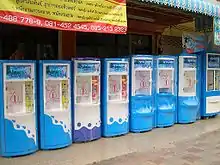

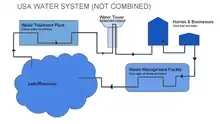
Water covers approximately 70% of the Earth's surface, where approximately 97.2% of it is saline, only 2.8% fresh. Potable water is available in almost all populated areas of the Earth, although it may be expensive and the supply may not always be sustainable. Sources where water may be obtained include springs, hyporheic zones and aquifers, and:
- Precipitation which includes rain, hail, snow, fog, etc.
- Surface water such as rivers, streams, glaciers
- Biological sources such as plants
- Desalinated seawater
- Water supply network
- Atmospheric water generators[11]
Threats for the availability of water resources include: water scarcity, water pollution, water conflict, insufficient well-depth, droughts and overpumping,[12] and the effects of climate change.
Consumption
Requirements for drinking
The amount of drinking water required per day is variable.[1] It depends on physical activity, age, health, and environmental conditions. In the United States, the Adequate Intake for total water, based on median intakes, is 3.7 litres (130 imp fl oz; 130 US fl oz) per day for human males older than 18, and 2.7 litres (95 imp fl oz; 91 US fl oz) per day for human females older than 18 which includes about 80% from beverages and 20% from food.[13] The European Food Safety Authority recommends 2.0 litres (70 imp fl oz; 68 US fl oz) of total water per day for adult women and 2.5 litres (88 imp fl oz; 85 US fl oz) per day for adult men.[14] The common advice to drink 8 glasses (1,900 mL or 64 US fl oz) of plain water per day is not based on science, and an individual's thirst provides a better guide for how much water they require rather than a specific, fixed quantity.[15] Americans age 21 and older, on average, drink 1,043 mL (36.7 imp fl oz; 35.3 US fl oz) of drinking water a day and 95% drink less than 2,958 mL (104.1 imp fl oz; 100.0 US fl oz) per day.[2] Physical exercise and heat exposure cause loss of water and therefore may induce thirst and greater water intake.[16] Physically active individuals in hot climates may have total daily water needs of 6 litres (210 imp fl oz; 200 US fl oz) or more.[16]
The drinking water contribution to mineral nutrients intake is also unclear. Inorganic minerals generally enter surface water and ground water via storm water runoff or through the Earth's crust. Treatment processes also lead to the presence of some minerals. Examples include calcium, zinc, manganese, phosphate, fluoride and sodium compounds.[17] Water generated from the biochemical metabolism of nutrients provides a significant proportion of the daily water requirements for some arthropods and desert animals, but provides only a small fraction of a human's necessary intake. There are a variety of trace elements present in virtually all potable water, some of which play a role in metabolism. For example, sodium, potassium and chloride are common chemicals found in small quantities in most waters, and these elements play a role in body metabolism. Other elements such as fluoride, while beneficial in low concentrations, can cause dental problems and other issues when present at high levels.
Fluid balance is key. Profuse sweating can increase the need for electrolyte (salt) replacement. Water intoxication (which results in hyponatremia), the process of consuming too much water too quickly, can be fatal.[18] Water makes up about 60% of the body weight in men and 55% of weight in women.[19] A baby is composed of about 70% to 80% water while the elderly are composed of around 45%.[20]
Household usage
In the United States, the typical water consumption per capita, at home, is 69.3 US gallons (262 l; 57.7 imp gal) of water per day.[21][22] Of this, only 1% of the water provided by public water suppliers is for drinking and cooking.[23] Uses include (in decreasing order) toilets, washing machines, showers, baths, faucets, and leaks.
Animals
The qualitative and quantitative aspects of drinking water requirements on domesticated animals are studied and described within the context of animal husbandry. However, relatively few studies have been focused on the drinking behavior of wild animals.
Water supply
The most efficient and convenient way to transport and deliver potable water is through pipes. Plumbing can require significant capital investment. Some systems suffer high operating costs. The cost to replace the deteriorating water and sanitation infrastructure of industrialized countries may be as high as $200 billion a year. Leakage of untreated and treated water from pipes reduces access to water. Leakage rates of 50% are not uncommon in urban systems.[24]
Springs are often used as sources for bottled waters.[25] Tap water, delivered by domestic water systems refers to water piped to homes and delivered to a tap or spigot. For these water sources to be consumed safely, they must receive adequate treatment and meet drinking water regulations.[26]
Because of the high initial investments, many less wealthy nations cannot afford to develop or sustain appropriate infrastructure, and as a consequence people in these areas may spend a correspondingly higher fraction of their income on water.[27] 2003 statistics from El Salvador, for example, indicate that the poorest 20% of households spend more than 10% of their total income on water. In the United Kingdom, authorities define spending of more than 3% of one's income on water as a hardship.[28]
Water quality
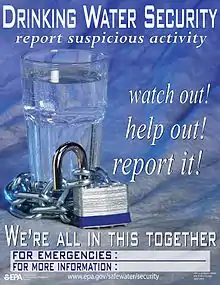
According to the World Health Organization's 2017 report, safe drinking-water is water that "does not represent any significant risk to health over a lifetime of consumption, including different sensitivities that may occur between life stages".[29]: 2
Parameters for drinking water quality typically fall within three categories: physical, chemical, microbiological.
Physical and chemical parameters include heavy metals, trace organic compounds, total suspended solids, and turbidity. Chemical parameters tend to pose more of a chronic health risk through buildup of heavy metals although some components like nitrates/nitrites and arsenic can have a more immediate impact. Physical parameters affect the aesthetics and taste of the drinking water and may complicate the removal of microbial pathogens.
Microbiological parameters include coliform bacteria, E. coli, and specific pathogenic species of bacteria (such as cholera-causing Vibrio cholerae), viruses, and protozoan parasites. Originally, fecal contamination was determined with the presence of coliform bacteria, a convenient marker for a class of harmful fecal pathogens. The presence of fecal coliforms (like E. Coli) serves as an indication of contamination by sewage. Additional contaminants include protozoan oocysts such as Cryptosporidium sp., Giardia lamblia, Legionella, and viruses (enteric).[30] Microbial pathogenic parameters are typically of greatest concern because of their immediate health risk.
Throughout most of the world, the most common contamination of raw water sources is from human sewage in particular human fecal pathogens and parasites. In 2006, waterborne diseases were estimated to cause 1.8 million deaths while about 1.1 billion people lacked proper drinking water.[31] In parts of the world, the only sources of water are from small streams that are often directly contaminated by sewage.
Pesticides, whether used in agriculture or domestically (e.g. homes, schools, businesses) are potential drinking water contaminants. Pesticides may be present in drinking water in low concentrations, but the toxicity of the chemical and the extent of human exposure are factors that are used to determine the specific health risk.[32]
Perfluorinated alkylated substances (PFAS) are a group of synthetic compounds used in a large variety of consumer products, such as food packaging, waterproof fabrics, carpeting and cookware. PFAS are known to persist in the environment and are commonly described as persistent organic pollutants. PFAS chemicals have been detected in blood, both humans and animals, worldwide, as well as in food products, water, air and soil.[33] Animal testing studies with PFAS have shown effects on growth and development, and possibly effects on reproduction, thyroid, the immune system and liver.[34] As of 2022 the health impacts of many PFAS compounds are not understood. Scientists are conducting research to determine the extent and severity of impacts from PFAS on human health.[35] PFAS have been widely detected in drinking water worldwide and regulations have been developed, or are under development, in many countries.[36]
Water treatment

Most water requires some treatment before use; even water from deep wells or springs. The extent of treatment depends on the source of the water. Appropriate technology options in water treatment include both community-scale and household-scale point-of-use (POU) designs.[37] Only a few large urban areas such as Christchurch, New Zealand have access to sufficiently pure water of sufficient volume that no treatment of the raw water is required.[38]
In emergency situations when conventional treatment systems have been compromised, waterborne pathogens may be killed or inactivated by boiling[39] but this requires abundant sources of fuel, and can be very onerous on consumers, especially where it is difficult to store boiled water in sterile conditions. Other techniques, such as filtration, chemical disinfection, and exposure to ultraviolet radiation (including solar UV) have been demonstrated in an array of randomized control trials to significantly reduce levels of water-borne disease among users in low-income countries,[40] but these suffer from the same problems as boiling methods.
Another type of water treatment is called desalination and is used mainly in dry areas with access to large bodies of saltwater.
Point of use methods
The ability of point of use (POU) options to reduce disease is a function of both their ability to remove microbial pathogens if properly applied and such social factors as ease of use and cultural appropriateness. Technologies may generate more (or less) health benefit than their lab-based microbial removal performance would suggest.
The current priority of the proponents of POU treatment is to reach large numbers of low-income households on a sustainable basis. Few POU measures have reached significant scale thus far, but efforts to promote and commercially distribute these products to the world's poor have only been under way for a few years.
Solar water disinfection is a low-cost method of purifying water that can often be implemented with locally available materials.[41][42][43][44] Unlike methods that rely on firewood, it has low impact on the environment.
Global access
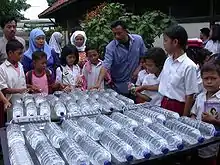
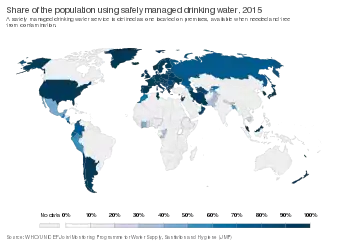
.jpg.webp)
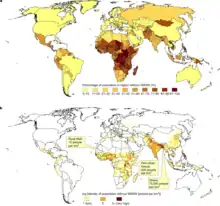
.jpg.webp)
According to the World Health Organization (WHO), "access to safe drinking-water is essential to health, a basic human right and a component of effective policy for health protection."[29]: 2 In 1990, only 76 percent of the global population had access to drinking water. By 2015 that number had increased to 91 percent.[45] In 1990, most countries in Latin America, East and South Asia, and Sub-Saharan Africa were well below 90%. In Sub-Saharan Africa, where the rates are lowest, household access ranges from 40 to 80 percent.[45] Countries that experience violent conflict can have reductions in drinking water access: One study found that a conflict with about 2,500 battle deaths deprives 1.8% of the population of potable water.[46]
By 2015, 5.2 billion people representing 71% of the global population used safely managed drinking water services.[47] As of 2017, 90% of people having access to water from a source that is suitable for drinking – called improved water source – and 71% of the world could access safely managed drinking water that is clean and available on-demand.[3] Estimates suggest that at least 25% of improved sources contain fecal contamination.[48] 1.8 billion people still use an unsafe drinking water source which may be contaminated by feces.[3] This can result in infectious diseases, such as gastroenteritis, cholera, and typhoid, among others.[3] Reduction of waterborne diseases and development of safe water resources is a major public health goal in developing countries. Bottled water is sold for public consumption in most parts of the world.
Improved sources are also monitored based on whether water is available when needed (5.8 billion people), located on premises (5.4 billion), free from contamination (5.4 billion), and within a 30-minute round trip.[47]: 3 While improved water sources such as protected piped water are more likely to provide safe and adequate water as they may prevent contact with human excreta, for example, this is not always the case.[45] According to a 2014 study, approximately 25% of improved sources contained fecal contamination.[48]
The population in Australia, New Zealand, North America and Europe have achieved nearly universal basic drinking water services.[47]: 3
As of 2015, American households use an average of 300 gallons of water a day.[49]
Monitoring
The WHO/UNICEF Joint Monitoring Program (JMP) for Water Supply and Sanitation[50] is the official United Nations mechanism tasked with monitoring progress towards the Millennium Development Goal (MDG) relating to drinking-water and sanitation (MDG 7, Target 7c), which is to: "Halve, by 2015, the proportion of people without sustainable access to safe drinking-water and basic sanitation".[51]
Access to safe drinking water is indicated by safe water sources. These improved drinking water sources include household connection, public standpipe, borehole condition, protected dug well, protected spring, and rain water collection. Sources that do not encourage improved drinking water to the same extent as previously mentioned include: unprotected wells, unprotected springs, rivers or ponds, vender-provided water, bottled water (consequential of limitations in quantity, not quality of water), and tanker truck water. Access to sanitary water comes hand in hand with access to improved sanitation facilities for excreta, such as connection to public sewer, connection to septic system, or a pit latrine with a slab or water seal.[52]
According to this indicator on improved water sources, the MDG was met in 2010, five years ahead of schedule. Over 2 billion more people used improved drinking water sources in 2010 than did in 1990. However, the job is far from finished. 780 million people are still without improved sources of drinking water, and many more people still lack safe drinking water. Estimates suggest that at least 25% of improved sources contain fecal contamination[48] and an estimated 1.8 billion people globally use a source of drinking water that suffers from fecal contamination.[53] The quality of these sources varies over time and often gets worse during the wet season.[54] Continued efforts are needed to reduce urban-rural disparities and inequities associated with poverty; to dramatically increase safe drinking water coverage in countries in sub-Saharan Africa and Oceania; to promote global monitoring of drinking water quality; and to look beyond the MDG target towards universal coverage.[55]
Definitions

A "safely managed drinking water service" is "one located on premises, available when needed and free from contamination".[47]
The terms 'improved water source' and 'unimproved water source' were coined in 2002 as a drinking water monitoring tool by the JMP of UNICEF and WHO. The term, improved water source refers to "piped water on premises (piped household water connection located inside the user’s dwelling, plot or yard), and other improved drinking water sources (public taps or standpipes, tube wells or boreholes, protected dug wells, protected springs, and rainwater collection)".[45]
International development
Expanding WASH (Water, Sanitation and Hygiene)[56] coverage and monitoring in non-household settings such as schools, healthcare facilities, and work places, is included in Sustainable Development Goal 6.[57]
WaterAid International is a non-governmental organization (NGO) that works on improving the availability of safe drinking water in some the world's poorest countries.[58]
Sanitation and Water for All is a partnership that brings together national governments, donors, UN agencies, NGOs and other development partners. They work to improve sustainable access to sanitation and water supply to meet and go beyond the MDG target.[59] In 2014, 77 countries had already met the MDG sanitation target, 29 were on track and, 79 were not on-track.[47]
Health aspects
Contaminated water is estimated to result in more than half a million deaths per year.[3] Contaminated water with the lack of sanitation was estimated to cause about one percent of disability adjusted life years worldwide in 2010.[60] As contaminated water takes its toll on the health of those exposed, the duration of exposure plays a part in the effects of certain diseases.
Diarrheal diseases
Over 90% of deaths from diarrheal diseases in the developing world today occur in children under five years old.[61]: 11 According to the WHO, the most common diseases linked with poor water quality are cholera, diarrhoea, dysentery, hepatitis A, typhoid, and polio.[62] Malnutrition, especially protein-energy malnutrition, can decrease the children's resistance to infections, including water-related diarrheal diseases. Between 2000 and 2003, 769,000 children under five years old in sub-Saharan Africa died each year from diarrheal diseases. As a result from poor water quality and bad sanitation, an estimated 829,000 people die each year from diarrhoea.[62] Only thirty-six percent of the population in the sub-Saharan region have access to proper means of sanitation. More than 2,000 children's lives are lost every day. In South Asia, 683,000 children under five years old died each year from diarrheal disease from 2000 to 2003. During the same period, in developed countries, 700 children under five years old died from diarrheal disease. Improved water supply reduces diarrhea morbidity by 25% and improvements in drinking water through proper storage in the home and chlorination reduces diarrhea episodes by 39%.[61]
Groundwater pollution
Some efforts at increasing the availability of safe drinking water have been disastrous. When the 1980s were declared the "International Decade of Water" by the United Nations, the assumption was made that groundwater is inherently safer than water from rivers, ponds, and canals. While instances of cholera, typhoid and diarrhea were reduced, other problems emerged due to polluted groundwater.
Sixty million people are estimated to have been poisoned by well water contaminated by excessive fluoride, which dissolved from granite rocks. The effects are particularly evident in the bone deformations of children. Similar or larger problems are anticipated in other countries including China, Uzbekistan, and Ethiopia. Although helpful for dental health in low dosage, fluoride in large amounts interferes with bone formation.[63]
Half of Bangladesh's 12 million tube wells contain unacceptable levels of arsenic due to the wells not dug deep enough (past 100 meters). The Bangladeshi government had spent less than US$7 million of the 34 million allocated for solving the problem by the World Bank in 1998.[63][64] Natural arsenic poisoning is a global threat with 140 million people affected in 70 countries globally.[65] These examples illustrate the need to examine each location on a case-by-case basis and not assume what works in one area will work in another.
Regulations
Guidelines for the assessment and improvement of service activities relating to drinking water have been published in the form of drinking water quality standards such as ISO 24510.[66]
For example, the EU sets legislation on water quality. Directive 2000/60/EC of the European Parliament and of the Council of 23 October 2000 establishing a framework for Community action in the field of water policy, known as the water framework directive, is the primary piece of legislation governing water.[67] This drinking water directive relates specifically to water intended for human consumption. Each member state is responsible for establishing the required policing measures to ensure that the legislation is implemented. For example, in the UK the Water Quality Regulations prescribe maximum values for substances that affect wholesomeness and the Drinking Water Inspectorate polices the water companies.
In the United States, public water systems, defined as systems that serve more than 25 customers or 15 service connections, are regulated by the U.S. Environmental Protection Agency (EPA) under the Safe Drinking Water Act.[23] [68] As of 2019 the EPA has issued 88 standards for microorganisms, chemicals and radionuclides.[69] The Food and Drug Administration regulates bottled water as a food product under the Federal Food, Drug, and Cosmetic Act.[70] All public water suppliers in the US must uphold a certain standard of water quality. If the requirements are met, Americans can drink their local tap water.[71]
See also
References
- Ann C. Grandjean (August 2004). "3" (PDF). Water Requirements, Impinging Factors, & Recommended Intakes. World Health Organization. pp. 25–34. Archived (PDF) from the original on 22 February 2016. This 2004 article focuses on the USA context and uses data collected from the US military.
- Exposure Factors Handbook: 2011 Edition (PDF). National Center for Environmental Assessment. September 2011. Archived from the original (PDF) on 24 September 2015. Retrieved 24 May 2015.
- "Water Fact sheet N°391". July 2014. Archived from the original on 5 June 2015. Retrieved 24 May 2015.
- "Drinking-water". World Health Organization. March 2018. Retrieved 23 March 2018.
- "Unsafe water kills more people than war, Ban says on World Day". UN News. 22 March 2010. Retrieved 10 May 2018.
- "Water in developing countries". GAC. 12 June 2017. Retrieved 4 October 2021.
- "WWDR1: Water for People – water for life" (PDF). UNESCO and Berghahn Books. 2003. Retrieved 21 September 2022.
- "Water Is Enough Reason to Visit Finland, Here's Why". Culture Trip. 4 June 2018. Retrieved 21 September 2022.
- "Water in Finland purest in the world". MEDI Connection. 22 March 2019. Retrieved 21 September 2022.
- "The quality of water produced by Turku Region Water is rated the best in the world by Unesco". City of Turku. 1 December 2021. Retrieved 21 September 2022.
- Lord, Jackson; Thomas, Ashley; Treat, Neil; Forkin, Matthew; Bain, Robert; Dulac, Pierre; Behroozi, Cyrus H.; Mamutov, Tilek; Fongheiser, Jillia; Kobilansky, Nicole; Washburn, Shane; Truesdell, Claudia; Lee, Clare; Schmaelzle, Philipp H. (October 2021). "Global potential for harvesting drinking water from air using solar energy". Nature. 598 (7882): 611–617. Bibcode:2021Natur.598..611L. doi:10.1038/s41586-021-03900-w. ISSN 1476-4687. PMC 8550973. PMID 34707305.
- Jasechko, Scott; Perrone, Debra (23 April 2021). "Global groundwater wells at risk of running dry". Science. 372 (6540): 418–421. Bibcode:2021Sci...372..418J. doi:10.1126/science.abc2755. ISSN 0036-8075. PMID 33888642. S2CID 233353207. Retrieved 10 May 2021.
- "US daily reference intake values". Iom.edu. Archived from the original on 6 October 2011. Retrieved 5 December 2011.
- EFSA Panel on Dietetic Products, Nutrition, and Allergies (2010). "Scientific Opinion on Dietary Reference Values for water". EFSA Journal. 8 (3): 1459. doi:10.2903/j.efsa.2010.1459.
{{cite journal}}: CS1 maint: multiple names: authors list (link) - H. Valtin, Drink at least eight glasses of water a day." Really? Is there scientific evidence for "8 × 8"? Archived 20 April 2010 at the Wayback Machine Am J Physiol Regul Integr Comp Physiol 283: R993-R1004, 2002.
- "Report Sets Dietary Intake Levels for Water, Salt, and Potassium To Maintain Health and Reduce Chronic Disease Risk". US Institute of Medicine, Food and Nutrition Board. 11 February 2004. Retrieved 13 September 2017.
- World Health Organization Archived 19 January 2011 at the Wayback Machine (WHO). Geneva, Switzerland. Joyce Morrissey Donohue, Charles O. Abernathy, Peter Lassovszky, George Hallberg. "The contribution of drinking-water to total dietary intakes of selected trace mineral nutrients in the United States." Draft, August 2004.
- Noakes, Timothy D.; Goodwin, Neil; Rayner, Brian L.; Branken, Trevor; Taylor, Robert K.N. (2005). "Water Intoxication: A Possible Complication During Endurance Exercise☆". Wilderness & Environmental Medicine. 16 (4): 221–227. doi:10.1580/1080-6032(2005)16[221:WIAPCD]2.0.CO;2. PMID 16366205. S2CID 28370290.
- Miller, Thomas A. (2006). Modern surgical care physiologic foundations and clinical applications (3rd ed.). New York: Informa Healthcare. p. 34. ISBN 978-1-4200-1658-1. Archived from the original on 1 September 2017.
- Nancy caroline's emergency care in the streets (07 ed.). [S.l.]: Jones And Bartlett Learning. 2012. p. 340. ISBN 978-1-4496-4586-1. Archived from the original on 1 September 2017.
- Mayer, P.W.; DeOreo, W.B.; Opitz, E.M.; Kiefer, J.C.; Davis, W.Y.; Dziegielewski, B.; & Nelson, J.O., 1999. Residential End Uses of Water. AWWARF and AWWA, Denver.
- William B. DeOreo, Peter Mayer, Benedykt Dziegielewski, Jack Kiefer. 2016. Residential End Uses of Water, Version 2. Water Research Foundation. Denver, Colorado.
- Joseph Cotruvo, Victor Kimm, Arden Calvert. “Drinking Water: A Half Century of Progress.” EPA Alumni Association. 1 March 2016.
- United Nations. World Water Assessment Programme (2009). "Water in a Changing World: Facts and Figures." Archived 24 June 2012 at the Wayback Machine World Water Development Report 3. p. 58 Accessed 13 June 2012.
- Schardt, David (2000). "Water, Water Everywhere". Washington, D.C.: Center for Science in the Public Interest. Archived from the original on 16 May 2009.
- Hall, Ellen L.; Dietrich, Andrea M. (2000). "A Brief History of Drinking Water." Archived 8 February 2015 at the Wayback Machine Washington: American Water Works Association. Product No. OPF-0051634, Accessed 13 June 2012.
- "The water vendors of Nigeria". 5 February 2009. Archived from the original on 22 October 2009. Retrieved 23 October 2009. BBC News The water vendors of Nigeria Referenced 20 October 2008
- "| Human Development Reports" (PDF). Retrieved 23 October 2009. page 51 Referenced 20 October 2008
- Guidelines for Drinking‑water Quality (PDF) (Report) (4 ed.). World Health Organization. 2017. p. 631. ISBN 978-92-4-154995-0.
- "Drinking Water Contaminants: Microorganisms". EPA. 21 September 2010. Archived from the original on 2 February 2015.
- "Safe Water System: A Low-Cost Technology for Safe Drinking Water" (PDF). Atlanta, GA: U.S. Centers for Disease Control and Prevention (CDC). March 2006. Archived from the original (PDF) on 10 October 2008.
- "Drinking Water and Pesticides". National Pesticide Information Center. Corvallis, OR: Oregon State University. 16 September 2021.
- "PFAS Explained". EPA. 18 October 2021.
- "Per- and Polyfluorinated Substances Factsheet". CDC. 16 August 2021.
- "Increasing Our Understanding of the Health Risks from PFAS and How to Address Them". EPA. 3 November 2021.
- Kurwadkar, Sudarshan; Danea, Jason; Kanel, Sushil R.; et al. (22 October 2021). "Per- and polyfluoroalkyl substances in water and wastewater: A critical review of their global occurrence and distribution". Science of the Total Environment. Elsevier. 809: 151003. doi:10.1016/j.scitotenv.2021.151003. PMID 34695467. S2CID 239494337.
- Centre for Affordable Water and Sanitation Technology. Calgary, Alberta. "Household Water Treatment Guide," March 2008. Archived 20 September 2008 at the Wayback Machine.
- "Our water – Water supply". Christchurch City Council. Christchurch, NZ. Archived from the original on 12 May 2015.
- World Health Organization, Geneva (2004). "Guidelines for Drinking-water Quality. Volume 1: Recommendations." Archived 4 March 2016 at the Wayback Machine 3rd ed.
- Clasen, T.; Schmidt, W.; Rabie, T.; Roberts, I.; Cairncross, S. (12 March 2007). "Interventions to improve water quality for preventing diarrhoea: systematic review and meta-analysis". British Medical Journal. 334 (7597): 782. doi:10.1136/bmj.39118.489931.BE. PMC 1851994. PMID 17353208.
- Conroy, RM.; Meegan, ME.; Joyce, T.; McGuigan, K.; Barnes, J. (October 1999). "Solar disinfection of water reduces diarrhoeal disease: an update". Arch Dis Child. 81 (4): 337–38. doi:10.1136/adc.81.4.337. PMC 1718112. PMID 10490440.
- Conroy, R.M.; Meegan, M.E.; Joyce, T.M.; McGuigan, K.G.; Barnes, J. (2001). "Solar disinfection of drinking water protects against cholera in children under 6 years of age". Arch Dis Child. 85 (4): 293–95. doi:10.1136/adc.85.4.293. PMC 1718943. PMID 11567937.
- Rose, A; Roy, S; Abraham, V; Holmgren, G; George, K; Balraj, V; Abraham, S; Muliyil, J; et al. (2006). "Solar disinfection of water for diarrhoeal prevention in southern India". Arch Dis Child. 91 (2): 139–41. doi:10.1136/adc.2005.077867. PMC 2082686. PMID 16403847.
- Hobbins M. (2003). The SODIS Health Impact Study, Ph.D. Thesis, Swiss Tropical Institute Basel
- Ritchie, Hannah; Roser, Max (2018), "Water Access, Resources & Sanitation", OurWorldInData.org, retrieved 22 March 2018
- Davenport, Christian; Mokleiv Nygård, Håvard; Fjelde, Hanne; Armstrong, David (2019). "The Consequences of Contention: Understanding the Aftereffects of Political Conflict and Violence". Annual Review of Political Science. 22: 361–377. doi:10.1146/annurev-polisci-050317-064057.
- Progress on Drinking Water, Sanitation and Hygiene (PDF) (Report). JMP, WHO and UNICEF. 2014. ISBN 978-92-4-151289-3. Retrieved 22 March 2018.
- Bain, R.; Cronk, R.; Wright, J.; Yang, H.; Slaymaker, T.; Bartram, J. (2014). "Fecal Contamination of Drinking-Water in Low- and Middle-Income Countries: A Systematic Review and Meta-Analysis". PLOS Medicine. 11 (5): e1001644. doi:10.1371/journal.pmed.1001644. PMC 4011876. PMID 24800926.
- "Drinking Water Regulations". www.epa.gov. 21 September 2015. Retrieved 4 October 2021.
- "About the JMP". JMP. WHO and UNICEF. Retrieved 16 October 2019.
- United Nations:World Water Assessment Program Archived 21 January 2008 at the Wayback Machine, accessed on 27 February 2010
- Meeting the MDG Drinking Water and Sanitation Target: A Mid-Term Assessment of Progress Archived 4 March 2016 at the Wayback Machine
- Bain, R.; Cronk, R.; Hossain, R.; Bonjour, S.; Onda, K.; Wright, J.; Yang, H.; Slaymaker, T.; Hunter, P.; Prüss-Ustün, A.; Bartram, J. (2014). "Global assessment of exposure to faecal contamination through drinking water based on a systematic review". Tropical Medicine & International Health. 19 (8): 917–27. doi:10.1111/tmi.12334. PMC 4255778. PMID 24811893.
- Kostyla, C.; Bain, R.; Cronk, R.; Bartram, J. (2015). "Seasonal variation of fecal contamination in drinking water sources in developing countries: A systematic review". Science of the Total Environment. 514: 333–43. Bibcode:2015ScTEn.514..333K. doi:10.1016/j.scitotenv.2015.01.018. PMID 25676921.
- "Progress on Drinking-water and Sanitation: 2012 Update" (PDF). Archived from the original (PDF) on 28 March 2012.
- "2021 water, sanitation and hygiene barometer" (PDF). SOLIDARITÉS INTERNATIONAL. 2021. Archived (PDF) from the original on 25 March 2021.
- Cronk, R.; Slaymaker, T.; Bartram, J. (2015). "Monitoring drinking water, sanitation, and hygiene in non-household settings: Priorities for policy and practice". International Journal of Hygiene and Environmental Health. 218 (8): 694–703. doi:10.1016/j.ijheh.2015.03.003. PMID 25836758.
- "Where we work". WaterAid. 26 October 2011. Archived from the original on 21 November 2011. Retrieved 5 December 2011.
- United Nations Children's Fund. UNICEF's engagement in Sanitation and Water for All (2012-07). "UNICEF's engagement in Sanitation and Water for All" Archived 3 January 2015 at the Wayback Machine.
- Engell, Rebecca E; Lim, Stephen S (June 2013). "Does clean water matter? An updated meta-analysis of water supply and sanitation interventions and diarrhoeal diseases". The Lancet. 381: S44. doi:10.1016/S0140-6736(13)61298-2. S2CID 54340036.
- Water for life: making it happen (PDF). WHO/UNICEF. 2005. ISBN 978-92-4-156293-5. Archived (PDF) from the original on 10 December 2013.
- "Drinking water".
- Pearce, Fred (2006). When the Rivers Run Dry: Journeys Into the Heart of the World's Water Crisis. Toronto: Key Porter. ISBN 978-1-55263-741-8.
- Bagla, Pallava (5 June 2003). "Arsenic-Laced Well Water Poisoning Bangladeshis". National Geographic News. Washington: National Geographic Society. Archived from the original on 2 October 2009.
- Bagchi, Sanjit (20 November 2007). "Arsenic threat reaching global dimensions" (PDF). Canadian Medical Association Journal. 177 (11): 1344–45. doi:10.1503/cmaj.071456. ISSN 1488-2329. PMC 2072985. PMID 18025421.
- ISO 24510 Activities relating to drinking water and wastewater services. Guidelines for the assessment and for the improvement of the service to users
- Maria, Kaika (April 2003). "The Water Framework Directive: A New Directive for a Changing Social, Political and Economic European Framework". European Planning Studies. 11 (3): 299–316. doi:10.1080/09654310303640. S2CID 153351550.
- United States. Safe Drinking Water Act. Pub.L. 93–523; 42 U.S.C. § 300f et seq. 16 December 1974.
- "National Primary Drinking Water Regulations". Ground Water and Drinking Water. EPA. 17 September 2019.
- United States. Federal Food, Drug, and Cosmetic Act. 25 June 1938, ch. 675, 52 Stat. 1040; 21 U.S.C. § 301 et seq.
- "What's in Your Drinking Water?". NRDC. 2 May 2017. Retrieved 4 October 2021.
External links
- U.S. Centers for Disease Control and Prevention (CDC) Healthy Water – Drinking Water One-stop resource for drinking water
- US Environmental Protection Agency – National drinking water program – General info, regulations & technical publications
- WHO – Water Sanitation and Health: drinking water quality